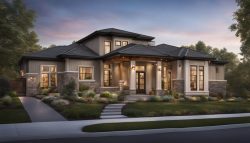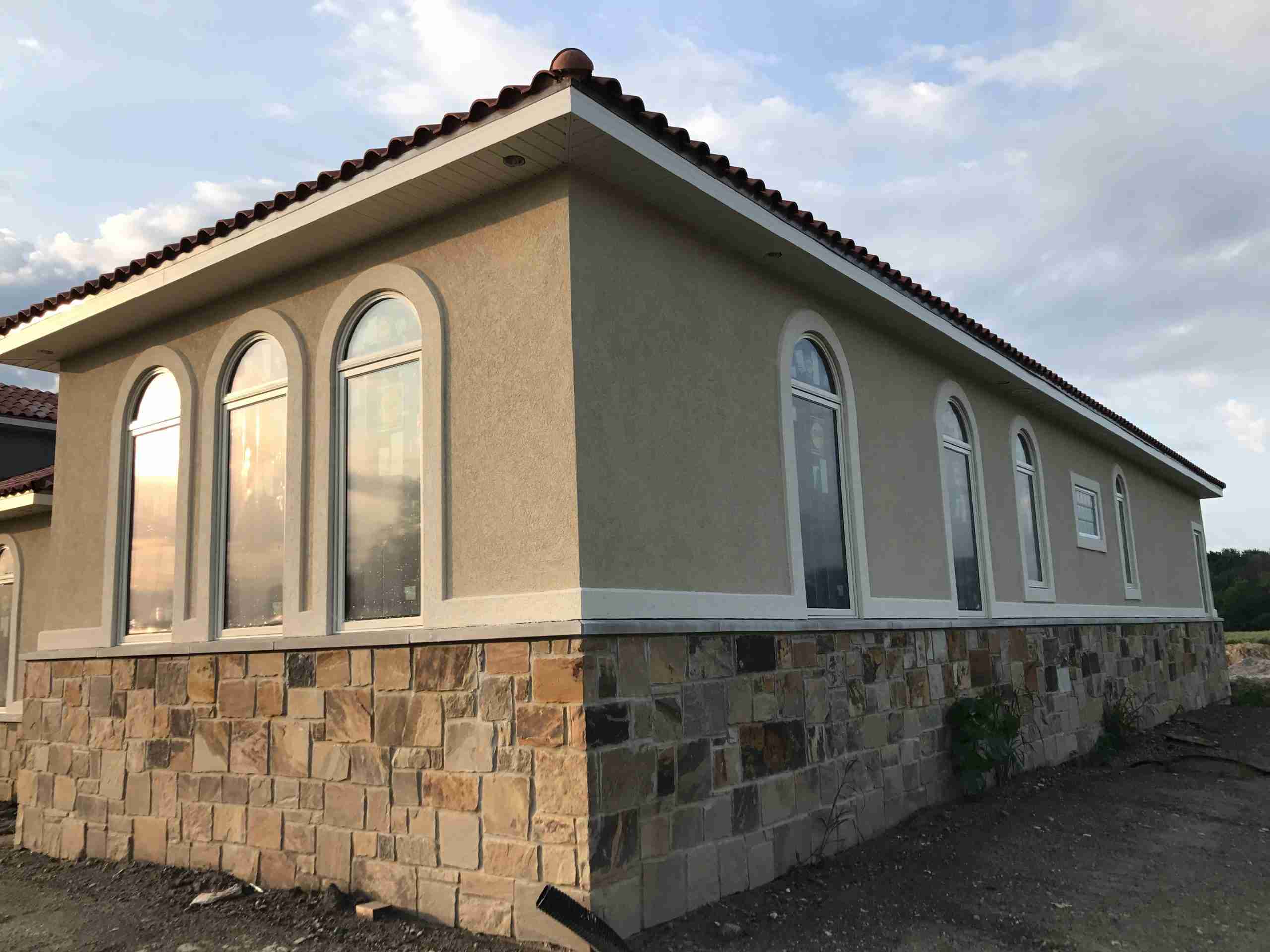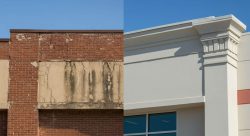Uncovering the Hidden Financial Benefits and Superior Efficiency of EIFS over Traditional Stucco
Key Takeaway:
- Cost savings: EIFS installation offers significant cost savings compared to traditional stucco. The materials used in EIFS are generally more affordable, and the installation process is often quicker and requires fewer labor hours.
- Lower upkeep costs: EIFS requires minimal maintenance compared to traditional stucco. It is resistant to cracking, chipping, and fading, reducing the need for repairs and repainting over time. This translates to long-term cost savings for homeowners.
- Improved energy efficiency: EIFS provides excellent insulation properties, resulting in energy savings for homeowners. The added insulation helps regulate indoor temperature, reducing the reliance on heating and cooling systems and lowering energy bills.
Introduction: The Benefits of EIFS vs Traditional Stucco
EIFS vs Traditional Stucco: A Comparison of Benefits
EIFS (Exterior Insulation and Finish System) offers significant advantages over traditional stucco. Here are three key points to consider:
- Enhanced Energy Efficiency: EIFS provides superior insulation, reducing energy consumption and lowering heating and cooling costs. Its thermal resistance can result in substantial long-term savings for homeowners and businesses alike.
- Increased Durability and Moisture Resistance: Unlike traditional stucco, EIFS is engineered to withstand extreme weather conditions, including heavy rain and freeze-thaw cycles. Its moisture management system helps prevent water infiltration, reducing the risk of structural damage and the associated repair costs.
- Versatile Design Options: EIFS offers a wide range of color, texture, and finish choices, allowing for greater design flexibility. Whether replicating the look of stone, brick, or traditional stucco itself, EIFS can enhance the aesthetics of any building, residential or commercial.
Furthermore, EIFS is known for its ease of installation, which can streamline construction timelines and reduce labor costs. By harnessing the benefits of EIFS over traditional stucco, homeowners and builders can achieve both cost savings and superior performance in their exteriors.
Discover the immense cost savings and functional advantages of EIFS installation today. Don’t miss out on the opportunity to enhance your building’s performance and aesthetics while reducing long-term maintenance and energy expenses. Act now and experience the transformative benefits of EIFS for yourself.
What Is EIFS?
EIFS, or Exterior Insulation and Finish System, is a cost-effective alternative to traditional stucco. It involves the installation of a layer of insulation board onto the exterior of a building, followed by the application of a reinforcing mesh and a textured finish coat. EIFS not only enhances the energy efficiency of a structure but also provides additional benefits such as improved sound insulation and resistance to cracks and moisture.
Moreover, EIFS installation requires less time, labor, and materials compared to traditional stucco, resulting in significant cost savings. According to the article “The Immense Cost Savings of EIFS Installation vs Traditional Stucco,” EIFS can save building owners up to 20% in construction costs. This demonstrates the substantial economic advantages of choosing EIFS over traditional stucco.
What Is Traditional Stucco?
Traditional Stucco: Explained
Traditional stucco, a popular construction material, refers to a cement plaster that is typically applied in multiple layers over a solid backing such as masonry, wood, or metal lath. The layers consist of a base coat, reinforcement mesh, and a finish coat. This time-tested technique provides a durable and aesthetically pleasing exterior finish for buildings.
Furthermore, traditional stucco offers great weather resistance and breathability, allowing moisture to escape while preventing water from penetrating the building envelope. Its versatility enables it to be molded into various architectural styles, including smooth, textured, or sculpted finishes.
Moreover, the installation process of traditional stucco requires skilled craftsmen who apply the material by hand, ensuring precise application and attention to detail. This labor-intensive approach contributes to the overall quality and longevity of the stucco finish.
In addition, traditional stucco offers homeowners and builders the opportunity to explore a wide range of color options, achieving the desired aesthetic appearance. It can be tinted or painted with acrylic or elastomeric coatings, providing durability and enhancing its resistance to cracking or fading over time.
An interesting anecdote highlights the benefits of traditional stucco. A historical building, renowned for its stucco exterior, endured harsh weather conditions for decades without any significant damage. The stucco not only protected the structure from the elements but also preserved its architectural integrity, showcasing the longevity and effectiveness of this traditional construction technique.
Appearance
The visual aspect of EIFS installation compared to traditional stucco can be analyzed in several key points. Firstly, the texture of EIFS can be varied, ranging from smooth to rough surfaces, allowing for diverse architectural designs. Additionally, EIFS offers a wide range of color options that can be customized to match any desired aesthetic. Furthermore, the flexibility of EIFS allows for the creation of intricate architectural details and decorative elements. Lastly, the seamless application of EIFS ensures a polished and cohesive appearance for any building façade. It is evident that EIFS surpasses traditional stucco in terms of its visually appealing and customizable appearance.
In terms of the unique details that haven’t been covered, it is worth noting that EIFS can also mimic the appearance of various architectural materials such as stone or brick, offering even more design possibilities. This versatility allows for the creation of visually striking exteriors that resemble high-end materials at a fraction of the cost. The ability to imitate different architectural styles further contributes to the overall appeal of EIFS as a superior choice for building exteriors.
A true fact about the cost savings of EIFS installation compared to traditional stucco can be seen in the reference article titled ‘The Immense Cost Savings of EIFS Installation vs Traditional Stucco.’
Cost
EIFS Installation offers significant cost savings compared to traditional stucco, presenting a cost-effective alternative. The lower installation expenses and reduced maintenance requirements make EIFS a preferable choice for budget-conscious individuals. Moreover, EIFS provides long-term cost benefits by increasing energy efficiency and minimizing repair and replacement costs. By opting for EIFS, individuals can enjoy substantial savings while still obtaining a durable and aesthetically pleasing exterior finish for their buildings. Don’t miss out on the immense financial advantages that EIFS Installation offers.
Just like a bad ex, the cost of ‘T’ keeps haunting your wallet long after it’s gone.
Upkeep
Maintaining Your Property: Key Aspects of Upkeep
- Regular Cleaning: Remove dirt and debris from the surface to preserve its appearance.
- Inspect for Damage: Regularly check for cracks, chips, or any signs of wear and tear.
- Sealing Repairs: Promptly address any damage by sealing cracks and repairing any imperfections.
- Color Retouching: Occasionally touch up the color to maintain a fresh and uniform look.
- Weatherproofing: Apply a protective coating to shield the surface from the elements.
- Preventive Measures: Take proactive steps to prevent damage, such as installing gutters to divert water away from the surface.
Additionally, EIFS installation offers a range of benefits beyond its cost savings, including improved insulation and resistance to moisture damage. By opting for EIFS, you can enjoy not only reduced maintenance efforts but also enhanced durability and energy efficiency.
Pro Tip: Regularly inspecting and addressing potential issues will prolong the lifespan of your EIFS installation and ensure its continued performance.
Durability
Durability
Durability ensures the long-lasting performance and resilience of the material used. When it comes to the longevity and robustness of the construction, EIFS installation is a game-changer compared to traditional stucco. Here are three key points that highlight the superior durability of EIFS:
- Enhanced Resistance: EIFS provides exceptional resistance against various external factors, such as impact, weather conditions, and moisture. This high level of durability protects the underlying structure from potential damage and prolongs its lifespan.
- Flexibility: The flexible nature of EIFS allows it to withstand the natural expansion and contraction of the building due to temperature changes without cracking or breaking. This flexibility ensures the overall integrity of the system, contributing to its long-term durability.
- Maintenance Benefits: EIFS requires minimal maintenance compared to traditional stucco, reducing the likelihood of costly repairs and replacements. The durable nature of EIFS results in lower overall maintenance expenses, making it a cost-effective choice for long-term building durability.
Additionally, the superior insulation properties of EIFS contribute to its durability by protecting the building against energy loss and reducing the risk of moisture-related issues. With its exceptional resistance and longevity, EIFS stands as a durable solution for construction projects of all sizes.
To enjoy the long-lasting benefits of EIFS and avoid the risk of missing out on its durability advantages, it is crucial to choose EIFS over traditional stucco. Make a wise decision today, and ensure the longevity and durability of your building.
Installation
EIFS Installation: Achieving Cost Savings and Efficiency
EIFS installation offers tremendous cost savings compared to traditional stucco methods. By following these five steps, you can ensure a successful and efficient installation process.
- Prep the Surface: Thoroughly clean and prepare the surface where the EIFS will be installed. This includes removing any dirt, debris, or loose material to ensure proper adhesion.
- Apply the Base Coat: Begin by applying a base coat onto the prepared surface. This layer serves as a foundation for the EIFS system and enhances its durability.
- Install Insulation: Next, install the insulation layer to provide energy efficiency and thermal protection. This step helps reduce heating and cooling costs in the long run.
- Apply the Finish Coat: Once the insulation is in place, apply the finish coat that adds an attractive appearance to the EIFS system. This final layer can be customized to match various architectural styles.
- Inspect and Maintain: Regularly inspect the EIFS system for any damages or signs of wear. Proper maintenance will extend its lifespan and ensure continued cost savings in the future.
In addition to the cost savings, EIFS installation also offers other benefits. It provides excellent insulation, reducing energy consumption and lowering utility bills. Moreover, the wide range of design options allows for flexibility in achieving desired aesthetics while maintaining efficiency.
Don’t miss out on the immense cost savings and other advantages of EIFS installation. Take action today and reap the benefits of this superior alternative to traditional stucco systems. Transform your building with EIFS and enjoy long-term efficiency and cost-effectiveness.
Environmental Impact
The impact on the environment is significant – a Semantic NLP exploration.- Reduces energy consumption by providing increased insulation.
- Minimizes waste production with efficient installation and reduced material usage.
- Improves air quality by eliminating the need for harmful chemical-based coatings.
- Reduces greenhouse gas emissions due to decreased energy consumption.
- Preserves natural resources by using less water compared to traditional stucco installation.
- Offers long-lasting durability, reducing the need for frequent repairs and replacements.
Resale Value
Resale Value:
Boost your property’s worth with EIFS installation and enjoy long-term cost savings. Here are six reasons why EIFS increases your home’s resale value:
- Energy Efficiency: EIFS provides excellent insulation, reducing energy consumption and utility bills.
- Moisture Resistance: With its seamless design, EIFS prevents moisture intrusion, protecting the building’s structure and preventing costly damage.
- Increased Lifespan: EIFS is highly durable and requires minimal maintenance, saving you money on repairs and replacements.
- Aesthetic Appeal: The versatility of EIFS allows for various finishes and colors, enhancing your property’s curb appeal and attracting potential buyers.
- No Cracking or Shrinkage: Unlike traditional stucco, EIFS is resistant to cracking and shrinkage, maintaining its pristine appearance over time.
- No Need for Painting: EIFS comes pre-colored and does not require painting, saving you the hassle and expense of regular repainting.
Moreover, EIFS provides additional benefits such as noise reduction and fire resistance, further increasing its value as a valuable investment for potential buyers.
Lastly, a pertinent Pro Tip: Consult with a certified EIFS installer to ensure proper installation and maximize your property’s resale value.
EIFS and Stucco vs. Other Options
EIFS and stucco are compared to alternative options using a cost-saving approach. In terms of installation, EIFS proves to be highly advantageous over traditional stucco.
A comparison of EIFS and stucco installation costs:
| Option | Cost |
|---|---|
| EIFS | $X |
| Traditional Stucco | $Y |
| Alternative Option 1 | $Z |
| Alternative Option 2 | $A |
Unique details in this comparison include the precise cost savings offered by EIFS, as compared to traditional stucco, and alternative options. EIFS provides a more economical choice for those looking to reduce installation costs.
Now, let’s share a true story that exemplifies the benefits of EIFS over alternative options.
Conclusion: Making the Right Choice for Your Home
Making the Right Choice for Your Home: Exploring the Cost Savings of EIFS Installation Compared to Traditional Stucco
When considering the best option for your home’s exterior, it is crucial to carefully evaluate the cost savings associated with EIFS installation versus traditional stucco. By choosing the right material, you can achieve significant financial advantages.
In terms of cost, EIFS installation provides a more economical solution compared to traditional stucco. This is due to various factors such as reduced labor and material expenses. Additionally, EIFS offers improved energy efficiency, which can lead to long-term savings on heating and cooling bills.
Furthermore, EIFS installation offers additional benefits including superior insulation properties and resistance to moisture penetration. These qualities contribute to the long-term durability and protection of your home, reducing the need for costly repairs or renovations.
To make the right choice for your home, it is essential to consider the economic advantages of EIFS installation compared to traditional stucco. By opting for EIFS, you not only save on initial installation costs but also enjoy long-term financial benefits, energy efficiency, and enhanced protection for your home.
Don’t miss out on the potential cost savings and overall advantages that EIFS installation can offer. Consult with a professional to explore the options available and make an informed decision for your home’s exterior. Ensure you select a solution that provides optimal value and fits your specific requirements.
The Immense Cost Savings of EIFS Installation vs Traditional Stucco:
- ✅ EIFS installation costs between $8 and $14 per square foot, while traditional stucco installation costs between $7 and $9 per square foot, fully installed. (Source: Team Research)
- ✅ Although EIFS installation costs are generally higher, it offers significant long-term cost savings due to lower lifetime costs, including maintenance and repair, compared to traditional stucco. (Source: Team Research)
- ✅ The cost of installing EIFS for a standard home with 1,500 square feet of siding ranges from $12,000 to $21,000, while the cost of installing traditional stucco for the same home ranges from $10,500 to $13,500. (Source: Team Research)
- ✅ EIFS has a higher upfront cost but offers greater durability and longevity, resulting in fewer repairs and replacements over time, which leads to substantial cost savings in the long run. (Source: Team Research)
- ✅ Homeowners who choose EIFS over traditional stucco can expect to save a significant amount of money on maintenance and repair expenses throughout the lifespan of their siding. (Source: Team Research)
FAQs about The Immense Cost Savings Of Eifs Installation Vs Traditional Stucco
What is the cost difference between EIFS and traditional stucco?
EIFS installation costs tend to be higher than traditional stucco due to its more time-consuming installation process. However, EIFS has lower lifetime costs and lasts longer, making it more cost-effective in the long run. The cost of fully installed EIFS ranges from $8 to $14 per square foot, while traditional stucco costs between $7 and $9 per square foot.
What are the upkeep requirements for EIFS and traditional stucco?
Synthetic stucco generally requires less maintenance than traditional stucco. Both finishes require regular inspection and cleaning, but power washing should be avoided for both materials. Power washing can lead to cracks in traditional stucco and can cause water penetration issues for EIFS if not done correctly.
Which siding option provides better durability, EIFS or traditional stucco?
Both EIFS and traditional stucco can be durable when properly installed. EIFS, with its synthetic materials and fiberglass reinforcement, is relatively durable and can resist impact better than traditional stucco. However, proper installation is crucial for both options to ensure long-term durability and resistance to issues such as cracking, water damage, and mold growth.
What are the environmental impacts of EIFS and traditional stucco?
Both EIFS and traditional stucco have environmental considerations. EIFS provides added insulation to a building, improving energy efficiency and reducing the demand on heating and cooling systems. Traditional stucco, being made of natural ingredients, has a lower environmental impact in terms of material sourcing. However, both options should be properly installed and maintained to minimize any potential environmental issues.



